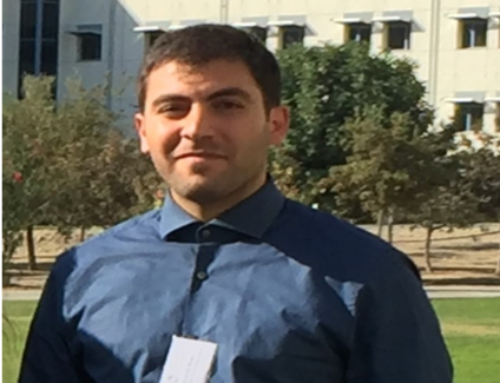Celia Prescott-Decie- 2022-ongoing
 I am currently a first-year PhD student at the University of Southampton supported by the Honor Frost Foundation. My current research aims to assess the impact of coastal change on the maritime cultural heritage of the Central Levantine coastline through a geophysical and hydrodynamic characterisation of the modern Lebanese coast. I have recently completed my master’s degree in Maritime Archaeology at the University of Southampton, also with the support of the Honor Frost Foundation.
I am currently a first-year PhD student at the University of Southampton supported by the Honor Frost Foundation. My current research aims to assess the impact of coastal change on the maritime cultural heritage of the Central Levantine coastline through a geophysical and hydrodynamic characterisation of the modern Lebanese coast. I have recently completed my master’s degree in Maritime Archaeology at the University of Southampton, also with the support of the Honor Frost Foundation.
I first became involved in archaeology through an interest in ancient languages, teaching myself Latin and Attic Greek in high school. I majored in English Literature with a minor in Archaeology at the American University of Beirut (AUB) with the hopes of developing this interest by focusing on ancient texts and participated in seasons of fieldwork at sites in Chekka and Baalbek. While at AUB, I took an introductory module on maritime archaeology which made me realise the importance of the sea as a facilitator of connectivity between the ancient cultures of the Levant and those surrounding it. Through this course I also learned of the work that the Honor Frost Foundation was doing to develop the discipline of maritime archaeology in Lebanon. I wanted to be a part of that work, and thus applied for the Foundation’s master’s scholarship.
During my time at the University of Southampton, I broadened my knowledge of the discipline of maritime archaeology both in general and Levantine contexts. Moreover, the opportunity to study at Southampton allowed me to gain qualifications in open water diving and practical skills in photogrammetry, GIS, and digital illustration. I also had the opportunity to attend several academic conferences such as the Postgraduate Research Archaeology Symposium (PGRAS) in Southampton, the Maritime Archaeology Conference, ‘Maritime Excavations in the UK’, in Bournemouth, and the Maritime Archaeology Graduate Symposium (MAGS) in Cyprus.
At the end of the year, I successfully completed my master’s dissertation entitled ‘Comparing Least-Cost Path and Circuit Theory Analysis for Modelling Maritime Mobility Across the Roman Levantine Basin’. The research aims to compare two methods for the representation of maritime mobility in an original Levantine context and reflects my initial interest in maritime archaeology as it relates to connectivity. The thesis is due to be presented at the ‘Computer Applications and Quantitative Methods in Archaeology’ (CAA) conference in Edinburgh this November.
As I continue to develop my research and practical skills at Southampton during this first year of my PhD, it is my hope that I will be able to contribute to the important work that the Honor Frost Foundation is doing to further the development of the field of maritime archaeology in Lebanon. Specifically, as my research aims to assess the impacts of coastal change on the coastal heritage of this region, I hope to be involved in the production of risk assessments for important coastal sites along the Lebanese coastline and the protection of its maritime cultural heritage.
Abstract of my master’s dissertation:
 GIS cost surface analysis has become the standard method for modelling past mobility. The most popular form of cost surface analysis is least-cost path analysis, which uses cost surfaces to chart single optimal paths between a set source and destination point. The limitations of least-cost path analysis are well-documented, and novel methods for modelling maritime mobility have been proposed to address them. The aim of this research is to apply one such method, circuit theory analysis, to the modelling of ancient seafaring over the Roman Levantine basin. More specifically, the purpose of this dissertation is to first apply circuit theory analysis to an original archaeological context and compare the results of this method to those of least-cost path analysis. Cost surfaces are prepared using wind data and representing the cost of sailing from the Roman coastal site of Berytus to destination points in Cyprus, Anatolia, Egypt and the Northern and Southern Levantine coastlines for the months of April, July, October, and January, and then used to produce least-cost paths and current maps depicting maritime mobility across the Levantine basin. By modelling several potential pathways, current maps represent connectivity as occurring in fluid zones rather than over strictly defined routes. The ‘blurriness’ of current maps means they are more capable of addressing common difficulties in modelling maritime mobility. However, least-cost paths and current maps react differently to differing weather conditions throughout the year, with the former showing far more variation in sailing routes. The implications of this research are then that the real strength of these methods is their use in complement. By continuing to apply new methods of modelling human-environment interaction in original contexts, and by setting them against more popular ones with known limitations, the newer methods are refined; their specific strengths and weaknesses identified so that their methodology can be continually adapted. Comparing methods of analysis forces the archaeologist to examine their biases when confronted with results that do not match, and thus understandings of connectivity in the past are further expanded.
GIS cost surface analysis has become the standard method for modelling past mobility. The most popular form of cost surface analysis is least-cost path analysis, which uses cost surfaces to chart single optimal paths between a set source and destination point. The limitations of least-cost path analysis are well-documented, and novel methods for modelling maritime mobility have been proposed to address them. The aim of this research is to apply one such method, circuit theory analysis, to the modelling of ancient seafaring over the Roman Levantine basin. More specifically, the purpose of this dissertation is to first apply circuit theory analysis to an original archaeological context and compare the results of this method to those of least-cost path analysis. Cost surfaces are prepared using wind data and representing the cost of sailing from the Roman coastal site of Berytus to destination points in Cyprus, Anatolia, Egypt and the Northern and Southern Levantine coastlines for the months of April, July, October, and January, and then used to produce least-cost paths and current maps depicting maritime mobility across the Levantine basin. By modelling several potential pathways, current maps represent connectivity as occurring in fluid zones rather than over strictly defined routes. The ‘blurriness’ of current maps means they are more capable of addressing common difficulties in modelling maritime mobility. However, least-cost paths and current maps react differently to differing weather conditions throughout the year, with the former showing far more variation in sailing routes. The implications of this research are then that the real strength of these methods is their use in complement. By continuing to apply new methods of modelling human-environment interaction in original contexts, and by setting them against more popular ones with known limitations, the newer methods are refined; their specific strengths and weaknesses identified so that their methodology can be continually adapted. Comparing methods of analysis forces the archaeologist to examine their biases when confronted with results that do not match, and thus understandings of connectivity in the past are further expanded.






